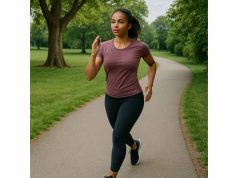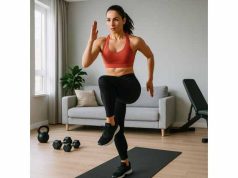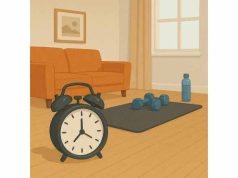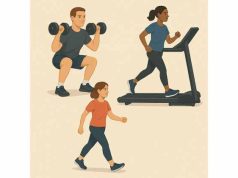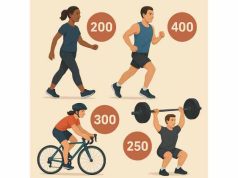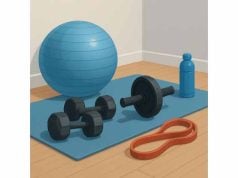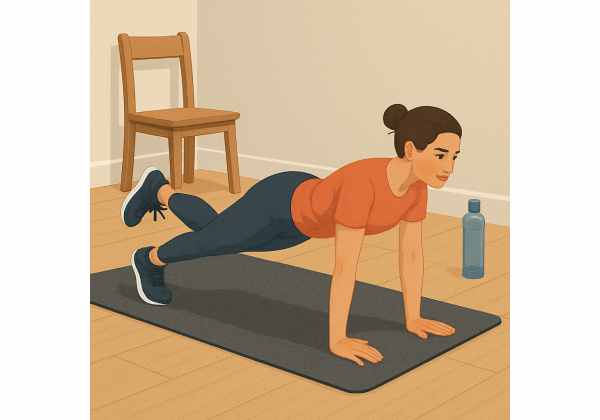
Bodyweight training removes friction: no commute, no equipment list, no excuses. With the right structure, you can stimulate every major muscle group, raise weekly energy expenditure, and keep joints happy—all in your living room or a park. This guide shows how to use simple movements to lose fat, protect muscle, and build the aerobic base that makes daily life easier. You’ll get a clear plan, progressions that never require gear, and practical fixes for common sticking points. For a quick overview of how strength, cardio, and steps work together, skim our primer on exercise options for weight loss before you start.
Table of Contents
- Why bodyweight works
- Structure your workouts
- Movement menu and form
- Beginner 4-week plan
- 20- and 30-minute circuits
- Progressions without weights
- Common issues and fixes
- Frequently Asked Questions
Why bodyweight works
Bodyweight training helps with weight loss by doing three jobs at once: it elevates your weekly energy burn, it signals your body to keep (or build) muscle while you diet, and it fits easily into busy weeks so you stay consistent. The simplest plan is the one you will repeat.
What makes it effective
- Big patterns, big return. Squat, hinge, push, pull, and carry/core movements recruit multiple joints and large muscle groups. They produce a high stimulus with little setup.
- Auto-progression. You can increase reps, slow tempo, add pauses, extend ranges, or reduce rest to create overload—no weights required.
- Low barrier, high adherence. No commute, no line for machines. A 15–30-minute session after work or before breakfast is doable most days.
- Joint-friendly by design. You control depth, speed, and impact. That makes it easier to train around old aches while still working hard.
How it supports fat loss
- Energy balance you can live with. Training burns calories directly and indirectly (you tend to move more the rest of the day when you feel fit).
- Muscle preservation. The deficit that makes you lose fat can also eat muscle. Resistance work says “keep this tissue,” which helps maintain daily energy expenditure.
- Behavior ripple effects. Bodyweight sessions improve sleep quality, appetite regulation, and mood for many people—making nutrition easier to sustain.
Expectations and pacing
- A realistic loss for many adults is 0.25–0.75 kg (0.5–1.5 lb) per week on average when training, steps, sleep, and nutrition align.
- Track weekly averages for weight and steps. Watch how clothes fit and how your sets feel.
- If you are new or returning after a layoff, start with two or three short sessions per week plus daily walking, then add volume.
For broader context on setting targets and judging progress, visit our concise hub on healthy weight-loss basics.
Structure your workouts
Great bodyweight sessions follow a simple rhythm: warm up → strength circuits → optional finisher → cool down. The goal is quality tension on the muscles with enough density to keep your heart rate up, not frantic cardio.
Session blueprint (~25–35 minutes)
- Warm-up (4–6 minutes)
- Easy march or stair walk (1–2 minutes).
- Dynamic mobility (6–8 reps each): hip hinges, ankle rocks, arm circles, thoracic rotations.
- Two 20–30-second “primers” at a brisk pace (step-overs, shadow boxing) with equal easy time.
- Strength circuits (14–20 minutes)
- Choose four moves: squat, push, hinge, pull/core.
- Work 40 seconds, rest 20 seconds, rotate through all four for 3–4 rounds.
- Keep 1–2 reps in reserve (RIR). If you hit failure early, shorten the work window or slow down.
- Optional finisher (4–6 minutes)
- 30s brisk / 30s easy × 6 with low-impact options (fast march, step-overs, shadow boxing).
- Purpose: conditioning dose, not punishment.
- Cool down (2–3 minutes)
- Easy walk until breathing normalizes; light calf, hip-flexor, and chest stretches if tight.
Intensity guide
- RPE 7–8/10 on work intervals (hard but repeatable); RPE 3–4/10 in recoveries.
- When in doubt, slow the tempo to raise challenge without losing form.
Programming rules that keep results coming
- Frequency: 3–5 sessions per week works well. Busy? Two sessions plus high steps can still move the needle.
- Progression: Change one variable at a time—reps, work time, rest time, range, or complexity.
- Alternation: Sequence lower- and upper-body moves to keep heart rate up while each region rests.
For quick warm-up flows that actually improve sessions (and recovery ideas that take three minutes), use our short guide on warm-up and recovery.
Movement menu and form
Use this menu to cover the five patterns. Start with the first option in each line; progress as control improves. Form cues are brief and practical.
Squat pattern
- Sit-to-stand → bodyweight squat → tempo squat (3-1-0) → split squat → front-foot-elevated split squat.
- Cues: Feet shoulder-width, ribs stacked over pelvis, knees track over middle toes, sit “between” your hips not “into” your knees, press the floor away.
Hinge pattern
- Hip hinge good-mornings → hip bridge → single-leg hip bridge → wide-stance hinge to target → skater good-mornings.
- Cues: Soft knees, long spine, push hips back until you feel hamstrings load; stand tall by driving hips forward, not by leaning into your low back.
Push pattern
- Wall push-up → incline push-up on counter → hands-elevated push-up on bench → floor push-up → narrow-grip push-up.
- Cues: Hands under shoulders, elbows at ~45°, body as one line, exhale gently as you press, keep ribs down.
Pull pattern (no bar, no bands)
- Isometric towel row (seated, pull against an anchored towel) → low-table inverted row (if available) → backpack row (load with books).
- Cues: “Chest proud,” draw elbow to back pocket, pause briefly, control the return.
Core and carry
- Dead bug → side plank (knees down → legs long) → bear hover hold → suitcase carry (load a tote with books, keep ribs stacked).
- Cues: Exhale to set ribs, keep pelvis level, move limbs without moving the trunk.
Cardio “spices”
- Quick step-overs (line on floor), high-knee march, shadow boxing, low-impact skaters, rope-less jump-rope rhythm (no impact).
- Use these in primers or finishers to elevate heart rate without pounding joints.
Range and tempo levers
- Tempo: 3-second lowers build control and tension.
- Pauses: 1–2 seconds at the bottom of squats or in the hinge end range improve stability.
- Range: Elevate the front foot for split squats to increase difficulty without speed.
Want a deeper dive into trunk training that matters for fat loss (not spot reduction)? See our practical guide to core training during fat loss.
Beginner 4-week plan
Start with a simple structure you can complete even on busy days. Each session takes about 25–30 minutes. Alternate Day A and Day B, aiming for three sessions per week (e.g., Mon–Wed–Fri). Walk on the other days.
Week 1–2
- Day A
- Warm-up 5 minutes.
- Circuit × 3 rounds — 40s work / 20s rest:
- Sit-to-stand or squat
- Incline push-up on counter
- Hip bridge
- Towel row (pull hard 15–20s within the 40s, relax and reset)
- Optional finisher: 30s step-overs / 30s easy × 4.
- Cool down 2–3 minutes.
- Day B
- Warm-up 5 minutes.
- Circuit × 3 rounds — 40s / 20s:
- Split squat (rear-foot light)
- Hands-elevated push-up
- Good-mornings (hip hinge)
- Side plank (switch sides each round)
- Optional finisher: 30s shadow boxing / 30s easy × 4.
- Cool down.
Week 3–4 (small progressions)
- Add a fourth round to one session each week.
- Or increase work to 45s while keeping 20s rest.
- Or add a 1–2 second pause at the bottom of squats and split squats.
- Keep RPE near 7–8/10; you should finish challenged, not wrecked.
Steps and recovery
- Choose a step range (e.g., floor/target/ceiling = 7k/10k/13k). Use short walks after meals and “walk the call” for phone time.
- Sleep 7–9 hours when possible; protein with each meal helps keep hunger in check.
Judging progress
- You repeat the same work with smoother control or more reps at the same RPE.
- Your step average climbs without extra fatigue.
- Clothes fit changes over 3–6 weeks even if the scale is noisy.
If you need help spacing effort and rest days as the plan grows, review our quick notes on rest-day planning.
20- and 30-minute circuits
When time is tight, use these plug-and-play circuits. They emphasize quality reps and repeatable intensity. No gear required.
20-minute “density” circuit (low impact)
- Warm-up (3 min): brisk march, hip hinges, arm circles.
- Main (14 min): 40s work / 20s rest × 7 cycles rotating:
- Bodyweight squat
- Incline push-up
- Good-mornings (hip hinge)
- Side plank (alternate sides)
- Cooldown (3 min): easy walk and gentle stretches.
20-minute “power-sparks” (experienced)
- Warm-up (3–4 min) with two brisk primers.
- Main (12 min): 20s hard / 40s easy × 12 rotating:
- Squat to calf raise (or low-impact jump for tolerant knees)
- Shadow boxing
- Mountain climbers (controlled core)
- Cooldown (4 min).
30-minute balanced session
- Warm-up (5 min).
- Strength circuit (16 min): 40s / 20s × 8 alternating:
- Split squat ↔ hands-elevated push-up
- Hip bridge ↔ towel row
- Finisher (6–7 min): 30s step-overs / 30s easy × 6–7.
- Cooldown (2–3 min).
Form guardrails
- Keep short ranges at speed; depth returns as control improves.
- If breathing spikes beyond control, extend your next rest by 10–20 seconds and resume.
- Stop a set if posture fails or joints feel sharp pain.
Like short, hard efforts? On very busy days, borrow ideas from our quick 20-minute HIIT sessions—but treat them as substitutes, not add-ons, when stress is high.
Progressions without weights
No equipment does not mean no progression. Use these levers to keep improving for months.
1) Rep and time progressions
- Add 2–4 total reps per movement across a session (e.g., from 10 to 12).
- Extend work windows by 5–10 seconds while keeping rest stable.
- Add a fourth round before changing exercises.
2) Range and leverage
- Squat deeper or elevate the front foot for split squats.
- In push-ups, move hands lower (less incline) over weeks.
- In bridges, progress to single-leg with a 1–2 second top pause.
3) Tempo and pauses
- 3-1-0 tempo: three seconds down, one second hold, normal up.
- Add end-range pauses in hinges and the bottom of squats to build control without load.
4) Density and rest
- Keep work time the same but cut rest by 5–10 seconds to raise density.
- Or maintain rest and increase rounds only when sets are crisp.
5) Complexity
- From bilateral to unilateral (split squats, single-leg bridges).
- From stable to less stable (tall-kneeling presses, bear hover holds) while keeping safety first.
6) Conditioning without impact
- Use shadow boxing, step-overs, and rope-less jump-rope rhythm to raise heart rate.
- String together short surges: 20s brisk / 40s easy × 10–12 at the end of a strength day.
7) Lifestyle levers
- Higher daily movement supports progress. If workouts feel stale, nudge steps up by 500–1,000 per day. For practical ideas, see how to increase NEAT without adding workouts.
Rule of thumb: If a new progression causes joint irritation or sloppy reps, revert for a week, then reintroduce more gradually.
Common issues and fixes
Even simple routines run into roadblocks. Use these quick diagnostics.
“I’m not losing weight.”
- Verify behaviors for two weeks: sessions completed, weekly step average, protein intake, bedtime.
- Adjust one lever: trim daily intake by 100–200 calories or add one circuit/round per workout. Hold the change 10–14 days before judging.
“I’m always sore.”
- You likely progressed too fast. Keep 1–2 reps in reserve, use 40/20 work-rest before 45/15, and deload every 4–6 weeks by cutting sets and intervals by 30–40%.
“My knees/hips/shins hurt.”
- Shorten stride, reduce depth temporarily, and bias hinges and bridges. Train squats to a box and choose low-impact finishers. If pain persists or alters your gait, see a clinician.
“Push-ups stall.”
- Build with isometric holds at the top (10–20 seconds), then partial-range reps. Keep elbows at 30–45° relative to your torso. Elevate hands higher and progress down in small steps.
“Core work strains my back.”
- Switch to dead bugs and side planks with shorter holds. Focus on exhaling to set ribs and pelvis, then move limbs without moving the trunk.
“I get bored.”
- Rotate movement variations, not patterns. Keep the squat, hinge, push, pull, and core slots but swap the version every 2–4 weeks.
Mindset cues that last
- Score the week by appointments kept, not by one heroic session.
- Use a minimum viable workout (15 minutes) on chaotic days so momentum never drops to zero.
- Track just enough to notice trends: session notes, step averages, and how clothes fit.
Frequently Asked Questions
Can I lose weight with bodyweight training only?
Yes. Combine bodyweight strength circuits (2–4 days/week) with high daily steps and a modest calorie deficit. You will progress faster by protecting muscle with resistance work, keeping cardio low impact and repeatable, and aiming for steady habits rather than extreme sessions.
How many days per week should I train?
Most beginners do well with three days of bodyweight circuits plus walking on the other days. Intermediates can handle four or five shorter sessions. Space hard days with easier ones so you recover and keep intensity repeatable across sets.
What if I cannot do push-ups or full squats yet?
Use incline push-ups (hands higher) and sit-to-stands or target-squats. As strength and control improve, lower the hands or target gradually. Slow tempos and 1–2-second pauses build capacity without joint strain or extra load.
Do I need HIIT for fat loss?
No. Intervals are optional. Many people prefer steady, low-impact finishers (step-overs, brisk marching) and see excellent results. If you enjoy HIIT, cap it at two days per week initially, keep efforts “hard but repeatable,” and avoid impact if joints complain.
How long before I see results?
Energy and control often improve within two weeks. Visible changes usually appear in 3–6 weeks when training, steps, sleep, and nutrition align. Track weekly averages for weight and steps, and use clothing fit and progress notes to judge trends.
Will ab exercises burn belly fat?
No. You cannot spot-reduce fat from one area. Core work strengthens the trunk, improves posture, and supports other lifts. Overall fat loss comes from a sustained calorie deficit paired with resistance training and daily movement.
References
- World Health Organization 2020 guidelines on physical activity and sedentary behaviour — 2020 (Guideline)
- Exercise training in the management of overweight and obesity in adults: synthesis of the evidence and recommendations from the European Association for the Study of Obesity Physical Activity Working Group — 2021 (Guideline/Position Statement)
- Resistance training effectiveness on body composition and body weight outcomes in individuals with overweight and obesity across the lifespan: A systematic review and meta-analysis — 2022 (Systematic Review/Meta-analysis)
- Effect of High-Intensity Interval Training vs. Moderate-Intensity Continuous Training on Fat Loss and Cardiorespiratory Fitness in the Young and Middle-Aged a Systematic Review and Meta-Analysis — 2023 (Systematic Review/Meta-analysis)
- Obesity – Treatment – NHS — 2017 (Guideline)
Medical Disclaimer
This article shares general fitness information and is not a substitute for personalized medical advice. Consult your healthcare professional before starting or changing an exercise or weight-loss program, especially if you have medical conditions, are pregnant or postpartum, or take medications that affect heart rate, blood pressure, or balance.
If this guide helped you, please consider sharing it with a friend. You’re welcome to follow us on Facebook or X for practical templates and calm, evidence-based advice.

